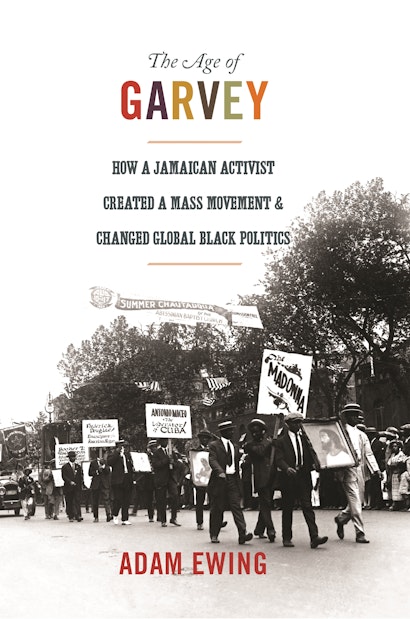Jamaican activist Marcus Garvey (1887–1940) organized the Universal Negro Improvement Association in Harlem in 1917. By the early 1920s, his program of African liberation and racial uplift had attracted millions of supporters, both in the United States and abroad. The Age of Garvey presents an expansive global history of the movement that came to be known as Garveyism. Offering a groundbreaking new interpretation of global black politics between the First and Second World Wars, Adam Ewing charts Garveyism’s emergence, its remarkable global transmission, and its influence in the responses among African descendants to white supremacy and colonial rule in Africa, the Caribbean, and the United States.
Delving into the organizing work and political approach of Garvey and his followers, Ewing shows that Garveyism emerged from a rich tradition of pan-African politics that had established, by the First World War, lines of communication among black intellectuals on both sides of the Atlantic. Garvey’s legacy was to reengineer this tradition as a vibrant and multifaceted mass politics. Ewing looks at the people who enabled Garveyism’s global spread, including labor activists in the Caribbean and Central America, community organizers in the urban and rural United States, millennial religious revivalists in central and southern Africa, welfare associations and independent church activists in Malawi and Zambia, and an emerging generation of Kikuyu leadership in central Kenya. Moving away from the images of quixotic business schemes and repatriation efforts, The Age of Garvey demonstrates the consequences of Garveyism’s international presence and provides a dynamic and unified framework for understanding the movement, during the interwar years and beyond.
Awards and Recognition
- Winner of the 2015 Stuart L. Bernath Book Prize, Society for Historians of American Foreign Relations
"This remarkable book has moved completely away from the stereotyping of Garvey's Africa program as an escapist ‘back to Africa' movement. Ewing has enhanced the study of the Garvey movement conceptually and empirically by tracing the networks and pathways of African Garveyism."—Rupert Lewis, New West Indian Guide
"The Age of Garvey is ambitious in its scope and argument, both of which are made clear by the book's title. Ewing succeeds in making the case for the worldwide nature and significance of Garveyism, bringing to bear his own meticulous original research in Africa, all of the relevant scholarship that is available, and his learned understanding of diversity within the global diaspora. It is hard to imagine a more coherent and informed presentation of this extremely complex and elusive subject."—Mary G. Rolinson, Nova Religio
"The story of Garvey and the UNIA is ripe for reinterpretation and increased appreciation. . . . Compelling."—William M. King, The Journal of African American History
"At last, an account of Garveyism worthy of its historic influence. Taking a unique approach to the twentieth century's first black power movement, Ewing shows how Garveyism became a dynamic force in the politics of the interwar years. His superlative book bridges the genres of intellectual, social, and cultural history to serve as a model for the study of transnationalism."—Vincent Brown, author of The Reaper's Garden
"The Age of Garvey takes a movement remembered as rigid and fleeting and brilliantly demonstrates its flexibility and longevity. The first to map Garvey's sweeping influence on three continents, this book captures how Garveyism functioned less as an ideology than as a method of organizing, making black diasporic consciousness both possible and desirable. We can never go back to thinking about the Garvey movement or black politics the same way again."—N. D. B. Connolly, author of A World More Concrete
"A groundbreaking historical narrative, The Age of Garvey sheds new light on the depth and breadth of Marcus Garvey's Universal Negro Improvement Association. Ewing's impressively researched and lucidly written account illuminates the sprawling political contours of a movement whose legacy still reverberates around the world."—Peniel E. Joseph, founding director of the Center for the Study of Race and Democracy, Tufts University
"The Age of Garvey promises to become a landmark in scholarship on global black politics. While deepening our knowledge of Marcus Garvey, Ewing shifts our attention to the lives and struggles of the millions of black men and women inspired by Garveyism. A sweeping chronicle, The Age of Garvey reveals like never before one of the largest, most global, and most influential antiracist movements in history. This is transnational history at its best."—Nico Slate, Carnegie Mellon University
"The Age of Garvey moves beyond the familiar, tragicomic 'rise and fall of Marcus Garvey' motif to emphasize his success as the propagandist and organizer of the largest black-led movement in world history. Illustrating Garveyism's enduring power as a coherent yet malleable set of liberationist ideals, this is a work of stunning geographic, temporal, and conceptual range."—Robert Trent Vinson, author of The Americans Are Coming!
"This remarkable piece of research, thinking, and writing is one of the very best historical works I've read in a long time. With authority and sophistication, Ewing provides a foundation for a global history of Garveyism in the twentieth century and shows why it is one of the century's most important political phenomena. This book establishes Ewing as one of the rising stars of his generation."—Steven Hahn, author of A Nation under Our Feet
"Well written and persuasively argued, this ambitious and innovative history of Garveyism engages the various manifestations of the movement from New York to Nyasaland. The Age of Garvey is an important contribution to the fields of African studies, African American studies, African history, and black internationalism."—Claudrena Harold, author of The Rise and Fall of the Garvey Movement in the Urban South

